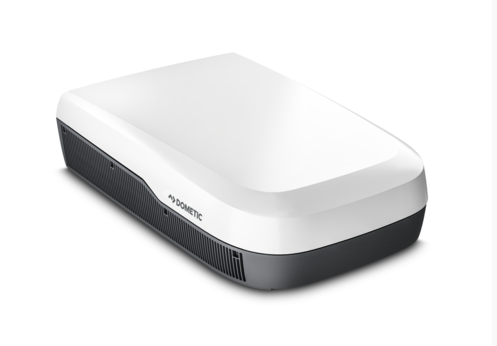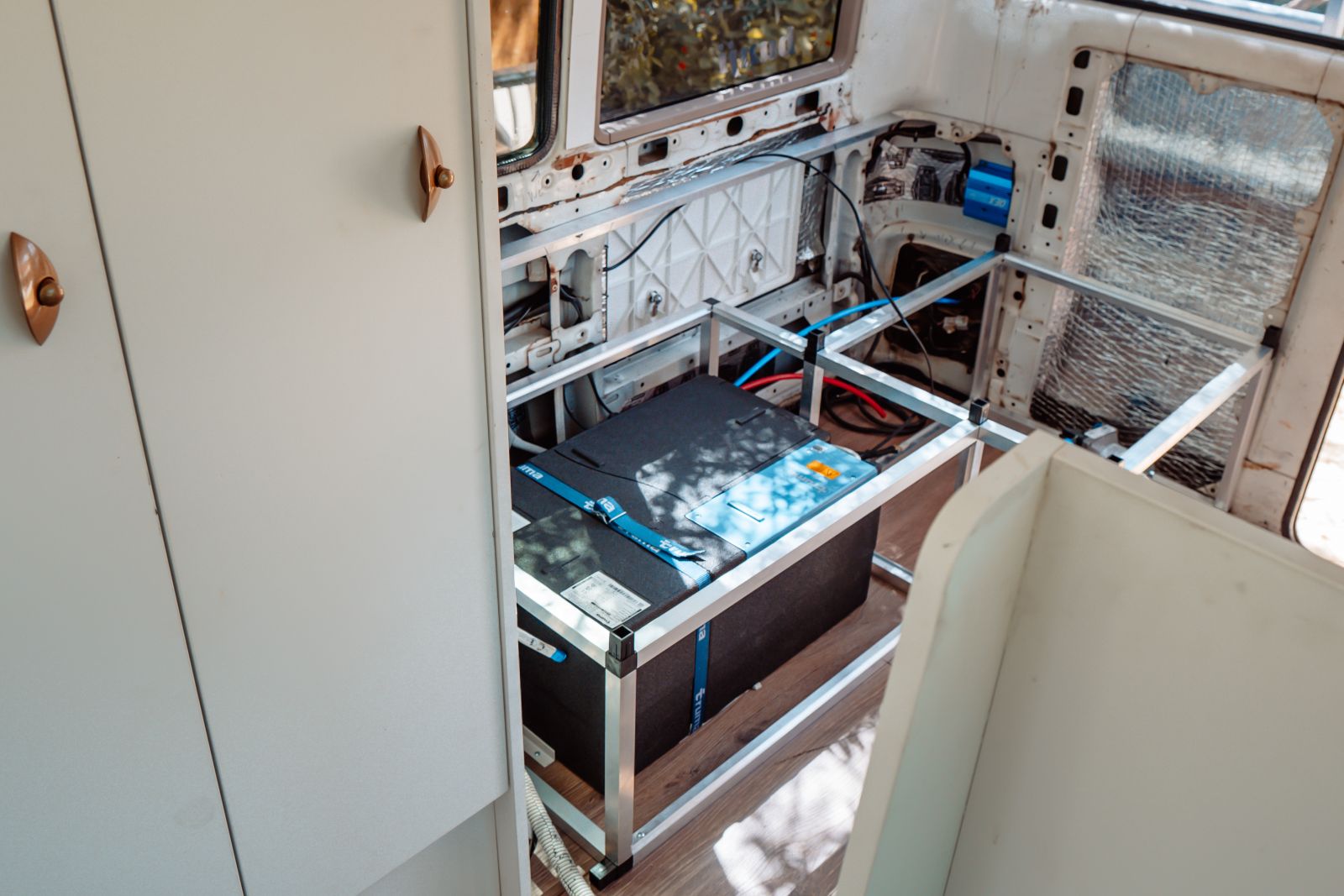Spend time travelling in a caravan/motorhome around Australia and an air conditioner can become a must-have, not a luxury. But caravan air conditioners don't come cheaply and there are a few different types. So you need to understand how each of them works before you decide which is best for your next adventure.
Let's be honest, tackling the Aussie outback or even a sunny coastal holiday without a decent caravan air conditioner can turn your dream trip into a sweaty nightmare. The Australian climate, with its scorching summers and unpredictable heatwaves, makes air conditioning less of a luxury and more of a necessity for comfortable caravanning.
Choosing the right caravan air conditioning unit is a significant decision. It's an investment in your travel comfort and can impact your off-grid capabilities. That's why understanding your options is crucial.
In this comprehensive guide, we'll walk you through everything you need to know to choose the best caravan air conditioner for your needs. We'll cover the different types available, key features to consider, and even touch on how to make the most of off grid caravan air conditioning. By the end of this guide, you'll be well-equipped to make an informed decision and ensure your future adventures are cool and comfortable.
Types of Caravan Air Conditioners
Choosing the right type of air conditioner is the first big step. Let's break down the main contenders:
Rooftop Air Conditioners
These are the workhorses of the caravan air conditioning world. Designed to fit snugly into a standard caravan roof vent opening – typically a 360x360mm or 400x400mm square – rooftop air conditioners sit neatly on top of your RV. It's worth noting that if your caravan has a 400x400 roof opening, you can still fit a 360x360 air conditioner using a simple adapter.
Advantages: The beauty of a rooftop air-con unit is that it keeps your precious interior space free. No bulky unit taking up room where you could be storing gear or kicking back. Plus, they're generally pretty straightforward to mount, making them a popular choice if your caravan is suited to this style. Some folks reckon having the unit on the roof makes it more efficient, as cool air naturally sinks.
Disadvantages: Rooftop units can be a tad noisy, which might bother light sleepers. They also add to the overall height of your caravan, so you'll need to be mindful of clearances when navigating car parks, garages, and low-hanging branches! While most are designed to be aerodynamic, some models are taller and wider than others, so it's something to keep in mind.
Ideal Applications: Perfect for full-sized caravans and motorhomes where roof space isn't an issue and interior space is at a premium.
Under-Bunk Air Conditioners
These are a clever solution, particularly if you have a pop-top caravan, camper trailer, or camper van with a single-skin roof. Why? Because adding the weight of a rooftop air conditioner can mess with the lifting mechanism on a pop-top. Under-bunk units, also known as built-in air conditioners, are typically split system or ducted units. They get tucked away neatly inside a cupboard or under a bench/bunk.
Advantages: The big advantage here is weight distribution. By keeping the weight low down, they're ideal for vehicles where roof weight is a concern. Plus, some say that because they're installed lower, they can cool the space quicker as they're starting with already cooler air.
Disadvantages: Installation can be a bit more involved as it often requires ducting and finding the right spot to install both the indoor unit and the external compressor. You'll also need to sacrifice some storage space for the unit itself.
Ideal Applications: Excellent for pop-top caravans, camper trailers, and campervans. Also a good option if you prefer a more discreet installation.
Portable Air Conditioners
These portable air conditioners are freestanding units on wheels that you can move around as needed. They typically vent hot air out through a window using a hose.
Advantages: The biggest plus is their flexibility and affordability. No permanent installation is required, so you can easily move them between your caravan and home. They're also generally the cheapest option upfront.
Disadvantages: Portable units are often less powerful than fixed options, so they might struggle to cool a larger caravan effectively, especially in extreme heat. They can also be bulky and take up valuable floor space, and the need to vent them out a window can be inconvenient and create a security concern. They can also be quite noisy.
Ideal Applications: Best for occasional use or for very small caravans where space and budget are major constraints.
Critical Factors For Selection
Alright, so you've got a handle on the different types of caravan air conditioners. Now, let's dive into the nitty-gritty of what you need to consider before making your final decision. Getting these factors right will ensure you stay cool without any unexpected headaches down the track, especially when you're out exploring our beautiful Aussie landscapes.
Caravan Size and Layout
Think of it like this: you wouldn't try to cool a whole house with a tiny window fan, right? The same principle applies to your caravan.Think about the length, width, and height of your caravan. Also, consider the layout. Does it have separate sleeping areas? Lots of windows that let in heat? These factors will influence the BTU rating you need.
Weight Considerations
This is a big one, especially if you're hitting the road for long trips. Every kilogram counts when it comes to towing. Adding a caravan air conditioner, particularly a rooftop unit, adds weight to your van.
Check your caravan's weight specifications and your tow vehicle's capacity. Factor in the weight of the air conditioner you're considering, as well as any additional mounting hardware. If you're opting for an under-bunk or split system, remember to account for the weight of both the internal and external components.
Noise Levels
Imagine finally settling down for a peaceful night's sleep after a long day of driving, only to be kept awake by a noisy air conditioner humming away. Not ideal, right? Air conditioners produce noise, and the level can vary significantly between models and types.
Things to Consider: Check the decibel (dB) rating of the air conditioner if it's provided. Lower dB ratings generally mean quieter operation. However, keep in mind that dB ratings are often measured under specific conditions, so reading real-world user reviews can give you a better sense of the actual noise level. Think about where the unit will be located in relation to your sleeping area.
Powering Your Caravan Air Conditioner
Think of your caravan air conditioner like any other appliance – it needs power to run! Here's the lowdown on how to keep it going. But first, how much power do caravan air conditioners consume?
We're not going to lie: your caravan air conditioner will likely be the most energy consuming item in your caravan. An average unit consumes between 1000 to 2000 watts, compared to around 100-200 watts for your laptop, 50-100 watts for your fridge, and 40-50 watts for a fan.
However this will only be an issue if you are using a generator to power it, as powered caravan sites don't charge by the kilowatt! Trying to run your camping air conditioner from a large battery or solar system can be done in some instances, but typically is not economical, so it's worth making sure your generator has the capacity to handle it.
If you're staying at a caravan park with power, you just plug your air conditioner into the power outlet, just like at home. Make sure your extension cord is good quality and you don't overload the power by running too many things at once.
If you're camping where there's no power, a generator can be your friend. BUT, air conditioners need a bit of extra power when they first turn on. So, you need a generator that's strong enough to handle this initial burst. Look for generators with "soft start" – it's like a gentle start for your air con and means you might be able to use a smaller generator.
Running your air con on sunshine power sounds great, right? It's possible, but it's the trickiest option. You need enough solar panels to collect power, big batteries to store it, and a special box called an "inverter" to change the battery power into the kind your air con needs. This setup can be expensive, and you need to be smart about how much you use the air con, especially if it's cloudy.
Top Caravan Air Conditioner Brands
Dometic has a solid reputation for being reliable, high quality and great value for money. Designed in Europe, these guys are at the cutting edge of recreational vehicle air conditioner technology, as illustrated by their release of the Dometic Harrier Inverter Air Conditioner in mid-2016; Featuring the first use of an inverter compressor in an RV application, the Dometic Harrier Inverter can help eliminate start-up current issues when running from generators or when current supply is restricted.
Dometic has expanded their range from one air conditioner with inverter technology to three. You may have heard of The Dometic Harrier Lite, IBIS 4 and Harrier Plus air conditioners. These have now been replaced with Dometic's most innovative air conditioner range - the FreshJet Series 7.There are three models: the FreshJet Pro, FreshJet Lite and FreshJet Plus.
These air conditioners can be run from good quality 2000W inverter generators, come with a three year warranty and are the quietest and most efficient models on the market due to their inverter technology.
These are perfect for caravanners who are looking for a balance of good cooling performance, reasonable power consumption, and a sleek design. Suitable for medium to large caravans where rooftop mounting is preferred. Plus The lighter weight can be a bonus for those concerned about overall van weight.
Truma is well known in the caravan / RV industry for their caravan heaters, hot water systems and air conditioners! They offer both rooftop and underbunk air conditioners, and their Truma Saphir Underbunk is one of the most popular models on the market.
Their Aventa rooftop air conditioner is well-regarded for its lightweight construction and notably quiet operation. Despite its light weight, the Aventa boasts impressive cooling capabilities and efficient power consumption. It often comes equipped with a multi-functional remote control. Features like a boost function for rapid cooling, timer settings, and dimmable LED lighting are common.
While their aesthetic might lean towards a more industrial look, Cool-J units are generally recognised for their strong cooling performance and durability, making them a reliable choice for those frequently travelling in very hot regions.
Houghton, with their Belaire range, offers another popular option, often striking a good balance between cooling power and affordability. The Belaire series encompasses various models with different features and BTU ratings, catering to a range of caravan sizes. Some Belaire models also include a reverse cycle heating function.
Finally, myCOOLMAN, while primarily known for their portable fridges, has recently entered the caravan air conditioner market with rooftop units. As a newer player, myCOOLMAN often focuses on efficiency and user-friendly features, potentially incorporating technology from their fridge range to achieve lower power consumption.
Climate-Specific Recommendations
Northern Australia: Tropical Conditions
Prioritise air conditioners with a high BTU rating to ensure sufficient cooling capacity. Look for models specifically designed to handle high humidity, sometimes advertised with dehumidification features. Power consumption can be a concern, especially if you're free camping, so consider efficient models and plan your power accordingly. Durability is also key, as these units will be working hard.
Central Australia: Extreme Temperatures
Look for air conditioners with a decent BTU rating for effective cooling. Strongly consider models with reverse cycle heating. Good quality air filters that are easy to clean are essential. Robust construction is also important to withstand the harsh conditions and potential vibrations on unsealed roads.
Southern Coastal Regions: Cooling and Heating Capabilities
Focus on air conditioners with a good balance of cooling capacity for those warmer days, but definitely prioritise models with a reliable reverse cycle heating function. You might not need the absolute highest BTU rating for cooling compared to those travelling in the tropics. Energy efficiency is still a good consideration.
Installation Guide: Getting Your Cool On
Check Compatibility: First things first, does your caravan actually suit the air conditioner you've bought? For rooftop units, ensure you have a standard roof vent opening of the correct size (usually 360x360mm or 400x400mm). For under-bunk or split systems, assess if you have suitable locations for both the indoor and outdoor units and a clear path for any necessary ducting or refrigerant lines.
Electrical Considerations: Know your caravan's electrical system. Where will you be drawing power from? Will you need to run new wiring? If you're unsure about electrical work, it's always best to consult a qualified auto electrician.
Read the Manual (Thoroughly!): Seriously, don't skip this step. The manufacturer's instructions are your bible for a successful installation. Pay close attention to any specific warnings or requirements.
Plan Your Workspace: Ensure you have enough space to work safely and comfortably around your caravan. Plus ensure you have all the right tools to complete the job.
If DIY is not for you, look for businesses that specialise in RV installations and have good reviews. Ask about their experience with the specific type of air conditioner you've purchased.
Post-installation Testing and Optimisation
Once the unit is installed, don't just pack up your tools and hit the road. Some testing is essential.
-
Check for Leaks: Especially important for rooftop and split systems. Check around the seals after the first rain or by gently hosing the area.
-
Test Cooling and Heating: Turn on the air conditioner and ensure it's cooling effectively. If it has a heating function, test that too.
-
Check Airflow: Ensure air is flowing properly from the vents inside the caravan.
-
Listen for Unusual Noises: Pay attention to any strange noises coming from the unit, which could indicate an installation issue.
-
Verify Electrical Connections: Double-check all electrical connections are secure.
-
Optimise Settings: Experiment with the thermostat and fan settings to find what's most comfortable and efficient for your needs.
Frequently Asked Questions: Your Burning Air Con Queries Answered
Q: Can I run my air conditioner on solar power?
A: The short answer is yes, you can, but it's not always straightforward and requires a significant investment. You'll need a substantial solar panel array to generate enough power, a high-capacity battery bank to store that energy, and a good quality inverter to convert the battery power to AC for the air conditioner. Keep in mind that air conditioners draw a fair bit of power, so running them for extended periods solely on solar might be challenging, especially on cloudy days. It's definitely more feasible with energy-efficient air conditioner models and a well-designed off-grid power system.
Q: What's the best type for a pop-top caravan?
A: Pop-top caravans present a unique challenge because of their lifting roof mechanism. Adding the weight of a standard rooftop air conditioner can often interfere with this mechanism. The generally recommended type for pop-tops is an under-bunk air conditioner. These units are installed inside a cupboard or under a seat, keeping the weight low and avoiding any issues with the roof. They're also a good option if you're keen to keep the overall height of your caravan down.
Q: Do caravan air conditioners need regassing?
A: Unlike your car's air conditioner, most modern caravan air conditioners are sealed units and do not typically require regassing. The refrigerant is contained within the system and should last the lifespan of the unit. If your caravan air conditioner isn't cooling as well as it used to, it's more likely to be an issue with airflow (like a blocked filter), electrical components, or a fault within the sealed system itself. In these cases, it's best to consult a qualified technician.
Wrapping Up: Staying Cool on the Road
Choosing the right air conditioner for your caravan boils down to a few key things. Think about the type that fits your van best – rooftop, under-bunk, split, or portable. Make sure it's got enough cooling power for your caravan size, especially if you're tackling the Aussie heat. Consider how you'll power it, especially if you're planning on camping off-grid. And don't forget about weight and how loud it is.
So, what are our final recommendations?
-
For most caravans, rooftop air cons are a good all-rounder.
-
If you have a pop-top, go for an under-bunk unit.
-
For quieter cooling in bigger vans, think about a split system.
-
If you only need it now and then, a portable one might do the trick.
Looking ahead, the world of caravan air conditioning is likely to see some exciting developments. We can expect to see even more energy-efficient models hitting the market, driven by advancements in compressor technology and a growing focus on off-grid capabilities. Smart features are also becoming more common, allowing you to control your air conditioner remotely via smartphone apps and integrate it with other caravan systems. We might also see more innovative designs that further reduce noise and improve aerodynamics.
Choosing the right caravan air conditioner is an investment in your travel comfort, especially when exploring our diverse and sometimes scorching Australian landscapes. By carefully considering your needs, your caravan, and the environments you'll be travelling in, you can ensure your future adventures are cool, comfortable, and unforgettable. Happy travels, and stay cool out there!
For more info on caravan air conditioners, check out our full range HERE.
-
DISCLAIMER* Please note, this advice is general in nature and we strongly recommend consulting the product manual and where relevant, a professional installer.
.jpeg)












